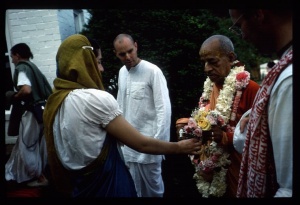CC Adi 17.42 (1975)

A.C. Bhaktivedanta Swami Prabhupada
Below is the 1996 edition text, ready to be substituted with the 1975 one using the compile form.
TEXT 42
- nitya rātre kari āmi bhavānī-pūjana
- āmāra mahimā dekha, brāhmaṇa-sajjana
SYNONYMS
nitya rātre—every night; kari—I do; āmi—I; bhavānī-pūjana—worship of Bhavānī, the wife of Lord Śiva; āmāra—my; mahimā—glories; dekha—you see; brāhmaṇa—sat-jana—all respectable brāhmaṇas.
TRANSLATION
“Gentlemen, every night I worship the goddess Bhavānī. Since the paraphernalia for the worship is present here, now all you respectable brāhmaṇas and members of the higher castes can understand my position.”
PURPORT
According to the Vedic system there are four castes—the brāhmaṇas, kṣatriyas, vaiśyas and śūdras—and below them are the pañcamas (literally, “members of the fifth group”), who are lower than the śūdras. The higher castes—the brāhmaṇas, the kṣatriyas and even the vaiśyas—were known as brāhmaṇa-saj-jana. The brāhmaṇas especially were known as saj-jana, or respectable gentlemen who guided the entire society. If there were disputes in the village, people would approach these respectable brāhmaṇas to settle them. Now it is very difficult to find such brāhmaṇas and saj-janas, and thus every village and town is so disrupted that there is no peace and happiness anywhere. To revive a fully cultured civilization, the scientific division of society into brāhmaṇas, kṣatriyas, vaiśyas and śūdras must be introduced all over the world. Unless some people are trained as brāhmaṇas, there cannot be peace in human society.